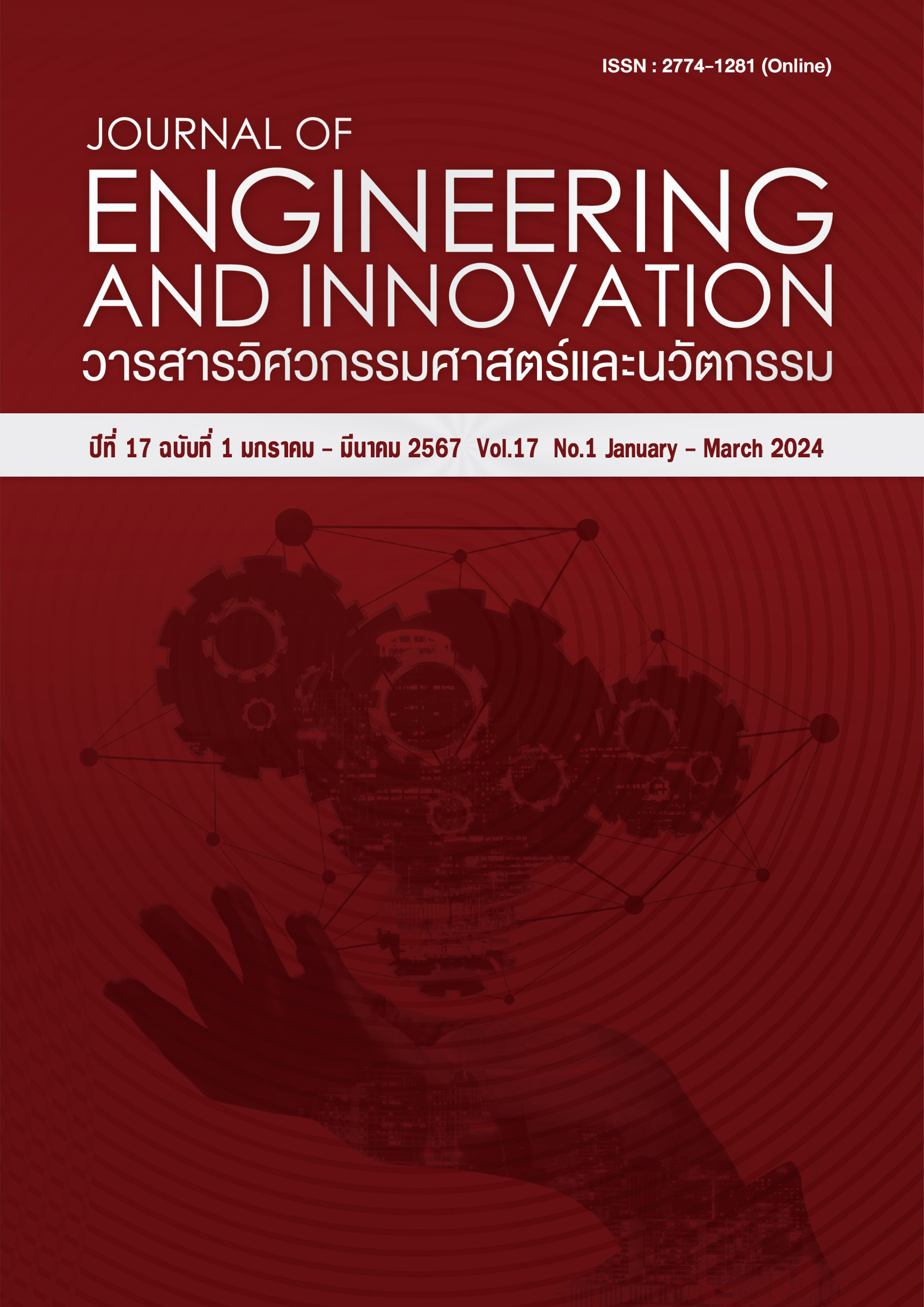Problems and Solutions of Online Learning during the COVID-19 Epidemic Using AHP and TOPSIS
Main Article Content
Abstract
The objective of this research was to study, analyze and rank the problems which had the most impact on online learning in the COVID-19 pandemic along with presenting and ranking solutions to problems in online learning from students' perspectives. The analytical hierarchical process (AHP) and technique for order of preference by similarity to ideal solution (TOPSIS) were applied together. This research started by collecting and grouping online learning problems and solutions. This research considered the undergraduate Engineering students in the case study of a department, 3rd-4th year at the university in Bangkok. Based on the results, the highest weight of importance was physical and mental stress. A large amount of work and a short exam time was of secondary importance, whereas the problem that students could not do practical experiments was the third priority weight. While inadequate equipment and internet signals including the unfavorable environment were ranked 4th and 5th, respectively. As for the result of calculating the significance weight of the solution obtained from the TOPSIS technique, the highest weight of importance was to adapt the learning measurement model and the workload appropriately. Physical and mental stress relief activities were of secondary importance, whereas providing Internet access equipment and reducing educational costs were the third priority weight. While seeking additional knowledge outside of school hours and increasing teaching in the classroom (on-site) including providing environments and making agreements with residents were ranked 4th and 5th, respectively.
Article Details
References
มนธิชา ทองหัตถา. สภาพการจัดการเรียนรู้แบบออนไลน์ในสถานการณ์การแพร่ระบาดของโรคติดเชื้อไวรัสโคโรนา 2019 (COVID-19) ของครูกลุ่มสาระการเรียนรู้ภาษาต่างประเทศ โรงเรียนปากพนัง จังหวัดนครศรีธรรมราช. วารสารลวะศรี มหาวิทยาลัยราชภัฏเทพสตรี. 2564;5(1): 43-51.
Raksa Content Team. โรคโควิด 19 (COVID-19). เข้าถึงได้จาก: https://www.doctorraksa.com/th-TH/blog/covid-19.html [เข้าถึงเมื่อ 1 มีนาคม 2565].
สุรชัย โชคครรชิตไชย. การระบาดของไวรัสโคโรนา (โควิด-19) ในประเทศไทย. วารสาสมาคมเวชศาสตร์ป้องกันแห่งประเทศไทย. 2563;10(1): ฎ.
ไทยรัฐออนไลน์. สรุปไทม์ไลน์ สถานการณ์ "โควิด-19" ในประเทศไทย จากวันที่พบผู้ติดเชื้อรายแรก สู่วันที่ผู้ติดเชื้อรายใหม่เป็นศูนย์. เข้าถึงได้จาก: https://www.thairath.co.th/news/society/1843259 [เข้าถึงเมื่อ 16 กุมภาพันธ์ 2565].
MARKETINGOOPS. ‘COVID-19’ ปฏิรูปการศึกษาทั่วโลก! ใช้เทคโนโลยีเรียนรูปแบบ ใหม่ – ‘มหาวิทยาลัยไทย’ สอนผ่านออนไลน์. เข้าถึงได้จาก: https://www.marketingoops.com/exclusive/business-case/covid-19-reinvent-global-education-system-with-educational-technology/ [เข้าถึงเมื่อ 14 กุมภาพันธ์ 2565].
กระทรวงการอุดมศึกษา วิทยาศาสตร์ วิจัยและนวัตกรรม. (2563). ประกาศ กระทรวงการอุดมศึกษา วิทยาศาสตร์ วิจัยและนวัตกรรม เรื่อง มาตารการและการเฝ้าระวังการระบาดของโรค ติดเชื้อไวรัสโคโรนา 2019 หรือโรคโควิด-19 (Coronavirus Disease 2019 (COVID-19)) (ฉบับที่ 3) : การปฏิบัติการของสถาบันอุดมศึกษาเพื่อป้องกันการแพร่ระบาดของโรคโควิด-19.
ฉัตรชัย ตวงรัตนพันธ์. COVID-19 Education Disruption ส่งผลต่อคุณภาพการศึกษาอย่างไร. เข้าถึงได้จาก: https://www.bangkokbiznews.com/ columnist/966219 [เข้าถึงเมื่อ 14 กุมภาพันธ์ 2565].
Saaty TL. What is the Analytic Hierarchy Process?. Springer Berlin Heidelberg; 1988. P.109-121.
Brunelli M. Introduction to the Analytic Hierarchy Process. Springer; 2014.
กสิณ รังสิกรรพุม. การวิเคราะห์การตัดสินใจสำหรับงานวิศวกรรม (Decision Analysis for Engineering). สำนักพิมพ์แห่งจุฬาลงกรณ์มหาวิทยาลัย; 2564.
Mu E, Pereyra-Rojas M. Practical Decision Making Using Super Decisions v3: An Introduction to the Analytic Hierarchy Process. Springer; 2017.
Hwang CL, Yoon K. Multiple Attribute Decision Making: Methods and Applications. New York: Springer-Verlag; 1981.
Yoon K. A reconciliation among discrete compromise situations. Journal of the Operational Research Society. 1987;38(3): 277–286.
Hwang CL, Lai YJ, Liu TY. A new approach for multiple objective decision making. Computers and Operational Research. 1993;20(8): 889–899.
El Alaoui M. Fuzzy TOPSIS: Logic, Approaches, and Case Studies. CRC Press; 2021.
Yamane T. Statistics: an Introductory Analysis-3. New York: Harper and Row; 1973.
Cirella GT, Russo AE. Sustainable interdisciplinarity: human-nature relations. Sustainability. 2019;12(1): 2.
Dhivyadeepa E. Sampling Techniques in Educational Research. Lulu.com; 2015.
ธเนศ เธียรนันทน์. ความคิดเห็นของประชาชนต่อผลการบริหารงานตามหลักธรรมาภิบาลของเทศบาลเมืองท่าช้าง อำเภอเมืองจันทบุรีจังหวัดจันทบุรี [วิทยานิพนธ์]. ชลบุรี: มหาวิทยาลัยบูรพา; 2556.
พัฒนา จิตติถาวร. การประยุกต์ใช้วิธีการ AHP และ TOPSIS ในการคัดเลือกเส้นทางปรับปรุงท่อประปาในพื้นที่สำนักงานประปาสาขาประชาชื่น [วิทยานิพนธ์]. กรุงเทพฯ: มหาลัยธุรกิจบัณฑิตย์; 2561.
Atthirawong W. Using multi criteria decision-making (MCMD) for green supplier selection. Proceedings of the International Conference, Simulation, Modelling and Simulation, ECMS 2019, 11-14 June 2019, Caserta, Area of Napoli. Italy. p. 330-335.
สิริพร อินทสนธิ์. โควิด – 19 : กับการเรียนการสอนออนไลน์ กรณีศึกษา รายวิชาการเขียนโปรแกรมเว็บ. วารสารวิทยาการจัดการปริทัศน์. 2563;22(2): 203-214.
อานันท์ สีห์พิทักษ์เกียรติ, ศิริพร เพียรสุขมณี, พจนา พิชิตปจจา, ชัยวุฒิ ตั้งสมชัย. โครงการวิจัยถอดบทเรียนการจัดการเรียนการสอนในรูปแบบออนไลน์ในช่วงสถานการณ์การแพร่ระบาดไวรัส COVID-19 ของมหาวิทยาลัยเชียงใหม่ [อินเทอร์เน็ต]. เชียงใหม่: ศูนย์นวัตกรรมการสอนและการเรียนรู้ มหาวิทยาลัยเชียงใหม่; 2564. เข้าถึงได้จาก: https://www.eqd.cmu.ac.th/km/research/COVID_Research_Fulltext.pdf [เข้าถึงเมื่อ 14 กุมภาพันธ์ 2565].
พงษ์พันธุ์ พันธุมจินดา. การประยุกต์ใช้ AHP และ TOPSIS ในการคัดเลือกแบตเตอรี่สำหรับชุมสาย : กรณีศึกษา ชุมสายบริษัทผู้ให้บริการด้านโครงข่าย. ในงานประชุมวิชาการ Business Innovation and Social Sciences [National Sessions]. 1 พฤษภาคม 2564, มหาวิทยาลัยธุรกิจบัณฑิตย์. p. 53-67.
Mohammed HJ, Kasim MM, Shaharanee IN. Evaluation of e-learning approaches using AHP-TOPSIS technique. Journal of Telecommunication, Electronic and Computer Engineering (JTEC). 2018;10(1-10): 7-10.
Iswari VD, Arini FY, Muslim MA. Decision support system for the selection of outstanding students using the AHP-TOPSIS combination method. Lontar Komputer : Jurnal Ilmiah Teknologi Informasi. 2019;10(1): 40-48.
Maqableh M, Alia M. Evaluation online learning of undergraduate students under lockdown amidst COVID-19 pandemic: the online learning experience and students’ satisfaction. Children and Youth Services Review. 2021;128: 106160.
Ransikarbum K, Pitakaso R, Kim N, Ma J. Multi-criteria decision analysis framework for part orientation analysis in additive manufacturing. Journal of Computational Design and Engineering. 2021;8(4): 1141-1157.
Ransikarbum K, Khamhong P. Integrated fuzzy analytic hierarchy process and technique for order of preference by similarity to ideal solution for additive manufacturing printer selection. Journal of Materials Engineering and Performance, 2021;30(9): 1-12.
Chanthakhot W, Ransikarbum K. Integrated IEW-TOPSIS and fire dynamics simulation for agent-based evacuation modeling in industrial safety. Safety. 2021;7(2): 47.
อภิวัฒน ยังวิลัย, นราธิป สุพัฒนธนานนท, รักนอย อัครรุงเรืองกุล. การจัดลําดับกระบวนการทํางานที่ส่งผลกระทบทางการยศาสตร์โดยประยุกต์ใช้การตัดสินใจแบบลําดับชั้นเชิงวิเคราะห์: กรณีศึกษากระบวนการทํางานฮอทไลน์ของการไฟฟ้าส่วนภูมิภาค. วารสารวิศวกรรมศาสตรและนวัตกรรม. 2565;15(1): 55-64.
ประกาศคณะกรรมการป้องกันและติดตามการแพร่ระบาดของโรค COVID-19 ฉบับที่ 9; 15 มีนาคม พ.ศ. 2563
ณิชกานต์ แก้วจันทร์, ธนินท์รัฐ รัตนพงศ์ภิญโญ. ความพร้อมในการจัดการเรียนการสอน และความคาดหวังประสิทธิผลการศึกษาในระบบการเรียน การสอนออนไลน์ในทรรศนะของนักศึกษาคณะวิทยาการจัดการ มหาวิทยาลัยศิลปากร. การประชุมวิชาการระดับชาติราชภัฏหมู่บ้านจอมบึงวิจัย ครั้งที่ 9. 1 มีนาคม พ.ศ.2564, มหาวิทยาลัยราชภัฏหมู่บ้านจอมบึง. 2564. p.138-148.
Kou G, Ergu D, Peng Y, Shi Y. Data Processing for the AHP/ANP. Springer Berlin Heidelberg; 2013.

